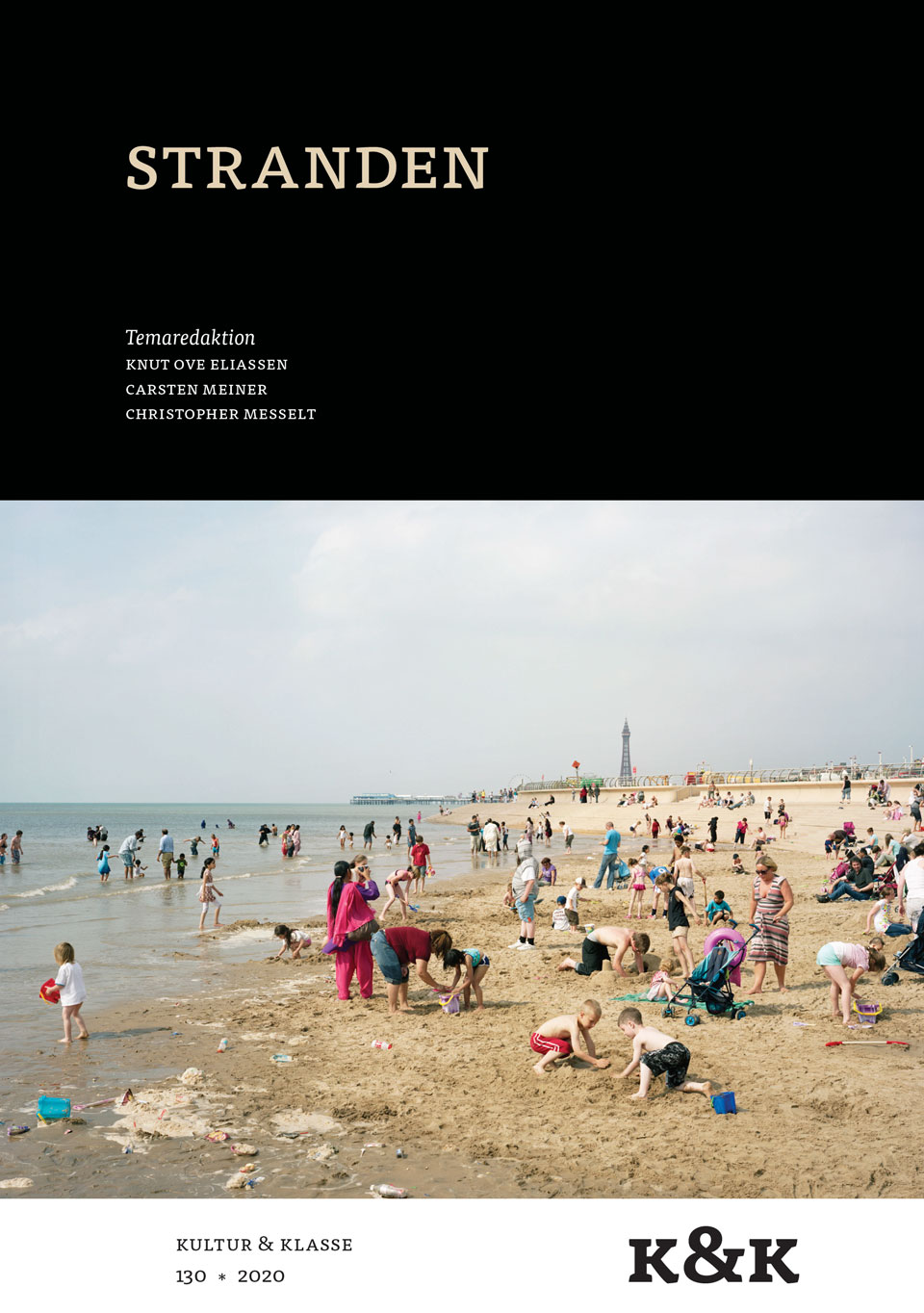Stranden hos Elena Ferrante
DOI:
https://doi.org/10.7146/kok.v48i130.123640Nøgleord:
topokritikk, litteratur og sted, middelhavsstranden, Italia, italiensk samtidslitteraturResumé
This article makes a topocritical reading of the Mediterranean beach in four works by the Italian contemporary novelist Elena Ferrante: L’amore molesto (1992), La figlia oscura (2006), La spiaggia di notte (2007) and L’amica geniale (2011-2014). The topocritical approach is here to be understood as the examination of the role played by geographical places in the formation of literary themes. The article argues that the beach as a setting has an important formative function in the development of key themes in Ferrante’s works, related to complex mother-daughter relations, gender roles, and social class. The analysis reveals how the texts mobilise and play with a set of culturally and historically conditioned perceptions of the beach: the border zone, the liminal area, the free zone, and the domesticated landscape. These perceptions serve to construct the beach as a symbolically charged landscape, which in turn helps shape the psychological, emotional, and social processes that the literary characters go through. The notion of the liminal area is particularly important, turning the beach into an emblematic place for the author’s thematization of in-between-ness.
Referencer
Benedetti, Laura. ”Il linguaggio dell’amicizia e della città: L’amica geniale di Elena Ferrante tra continuità e cambiamento”. Quaderni d’italianistica 33 2 (2012): 171-87.
Berrino, Annunziata. Storia del turismo in Italia. Bologna: Società editrice il Mulino, 2011.
Colette. Le blé en herbe. Paris: Flammarion, 1974 (1923).
Corbin, Alain. Le territoire du vide. L’occident et le désir de rivage. Paris: Flammarion, 2018 [1988].
Eliassen, Knut Ove, Christian Dahl og Michael Høxbro Andersen. ”Toposlærens aktualitet”. Kultur & Klasse 45 123 (2017): 1-12. https://doi.org/10.7146/kok.v45i123.96825
Ferber, Michael. A dictionary of literary symbols. Cambridge: Cambridge University Press, 2007 [1999].
Falotico, Caterina. ”Elena Ferrante: Il ciclo dell’Amica geniale tra autobiografia, storia e metaletteratura”. Forum Italicum 49 1 (2015): 92-118. https://doi.org/10.1177/ 0014585815578573
Ferrante, Elena. Den dunkle dottera. Overs. Sørsdal, Kristin. Oslo: Samlaget, 2017.
Ferrante, Elena. Frantumaglia. Nuova edizione ampliata. Roma: Edizioni e/o, 2016 (2003).
Ferrante, Elena. Historia om det nye namnet : unge år. Overs. Sørsdal, Kristin. Napoli-kvartetten. Vol. 2. Oslo: Samlaget, 2015.
Ferrante, Elena. I giorni dell’abbandono. Roma: Edizioni e/o, 2015 [2002].
Ferrante, Elena. Kvelande kjærleik. Overs. Sørsdal, Kristin. Oslo: Samlaget, 2018.
Ferrante, Elena. L’amica geniale : infanzia, adolescenza. L’amica geniale. Vol. 1. Roma: Edizioni e/o, 2011.
Ferrante, Elena. L’amore molesto. Roma: Edizioni e/o, 2015 [1992].
Ferrante, Elena. La figlia oscura. Roma: Edizioni e/o, 2006.
Ferrante, Elena. La vita bugiarda degli adulti. Roma: Edizioni e/o, 2019.
Ferrante, Elena. Mi briljante venninne : barndom, tidleg ungdom. Overs. Sørsdal, Kristin. Napoli-kvartetten. Vol. 1. Oslo: Samlaget, 2015.
Ferrante, Elena. Storia della bambina perduta : maturità - vecchiaia. L’amica geniale. Vol. 4. Roma: Edizioni e/o, 2014.
Ferrante, Elena. Storia del nuovo cognome : giovinezza. L’amica geniale. Vol. 2. Roma: Edizioni e/o, 2012.
Ferrante, Elena. Storia di chi fugge et di chi resta : tempo di mezzo. L’amica geniale. Vol. 3. Roma: Edizioni e/o, 2013.
Ferrante, Elena og Mara Cerri. La spiaggia di notte. Roma: Edizioni e/o, 2007.
Ferrante, Elena og Mara Cerri. Natt på stranda. Overs. Sørsdal, Kristin. Oslo: Samlaget, 2017.
Gennep, Arnold van. Overgangsriter – Rites de passage. Overs. Ringen, Erik. Oslo: Pax, 1999 [1919].
Gracq, Julien. Un beau ténébreux. Paris: José Corti, 1945.
Lageiste, Jérôme. ”La plage, un objet géographique de désir”. Géographie et cultures 67 (2008): 7-26. https://doi.org/10.4000/gc.1002
Lyngstad, Anne Berit. Litterær selvfremstilling som handling og terskelfenomen: performance, performativitet og liminalitet hos Jonny Halberg, Kjersti Annesdatter Skomsvold og Karl Ove Knausgård. Doktoravhandling, Norges teknisk-naturvitenskapelige universitet, 2018. http://hdl.handle.net/11250/2582850
Mann, Thomas. Der Tod in Venedig : Novelle. Berlin: S. Fischer, 1913 [1912].
Meethan, Kevin. ”Walking the edges: Towards a visual ethnography of beachscapes”. Liminal Landscapes: Travel, Experience and Spaces In-between. Red. Hazel Andrews og Les Roberts. London; New York: Routledge, 2012. 69-86.
Merritt, Melissa Mcbay. ”Motherhood in Ferrante’s The Lost Daughter: A Case Study of Irony as Extraordinary Reflection”. Philosophy and Literature 41 1 (2017): 185-200.
Milkova, Stiliana. ”Mothers, Daughters, Dolls: On Disgust in Elena Ferrante’s La figlia oscura.” Italian Culture, 31 2 (2013), 91-109. https://doi.org/10.1179/0161462213Z. 00000000017
Mitterand, Henri. ”Terre, terrain, territoire. Variations géocritiques balzaciennes”. Balzac géographe: Territoires. Red. Philippe Dufour og Nicole Mozet. Saint-Cyr-sur-Loire: Christian Pirot éditeur, 2004. 17-24.
Palma, Pina. ”Farewell to Naples: Ferrante’s Story of a New Name”. Forum Italicum 52 2 (2018): 471-84. https://doi.org/10.1177/0014585818757206
Pavese, Cesare. La spiaggia. Torino: Einaudi, 2017 [1942].
Pic, Rafael. Balnéaire: une histoire des bains de mer. Paris: Editions LBM / Phileas Fogg, 2004.
Proust, Marcel. À l’ombre des jeunes filles en fleur. À la recherche du temps perdu. Vol. 2. Paris: Gallimard, 1988 [1918].
Sambuco, Patrizia. Corporeal Bonds: The Daughter-mother Relationship in Twentieth Century Italian Women’s Writing. Toronto; Buffalo; London: University of Toronto Press, 2012. https://doi.org/10.3138/9781442699496
Sciascia, Leonardo. ”Il lungo viaggio”. Il mare colore del vino. Torino: Einaudi, 1973.
Thomassen, Bjørn. ”Revisiting Liminality: The Danger of Empty Spaces.” Liminal Landscapes: Travel, Experience and Spaces In-between. Red. Hazel Andrews og Les Roberts. London; New York: Routledge, 2012. 21-35.
Urbain, Jean-Didier. Sur la plage : mœurs et coutumes balnéaires (XIXe-XXe siècles). Paris: Éditions Payot & Rivages, 2002.
Violi, Patrizia. ”Il Mediterraneo tra passioni d’elite e turismo di mass”. E/C: rivista dell’Associazione Italiana di studi semiotici VI 11/12 (2012): 222-26.
Violi, Patrizia. ”Il sistema Mediterraneo: la realtà semiotica di una regione geografica”. Effetto Med: immagini, discorsi, luoghi. Red. Patrizia Violi og Anna Maria Schurr-Lorusso. Bologna: Logo Fausto Lupetti Editore, 2011. 7-39.
Wehling-Giorgi, Katrin. ”Playing with the Maternal Body: Violence, Mutilation, and the Emergence of the Female Subject in Ferrante’s Novels”. California Italian Studies 7 1 (2017): 1-15. https://escholarship.org/uc/item/02d156h0
Westphal, Bertrand. La géocritique: réel, fiction, espace. Paris: Les Éditions de Minuit, 2007.
Downloads
Publiceret
Citation/Eksport
Nummer
Sektion
Licens
Tidsskriftet følger dansk ophavsret.





